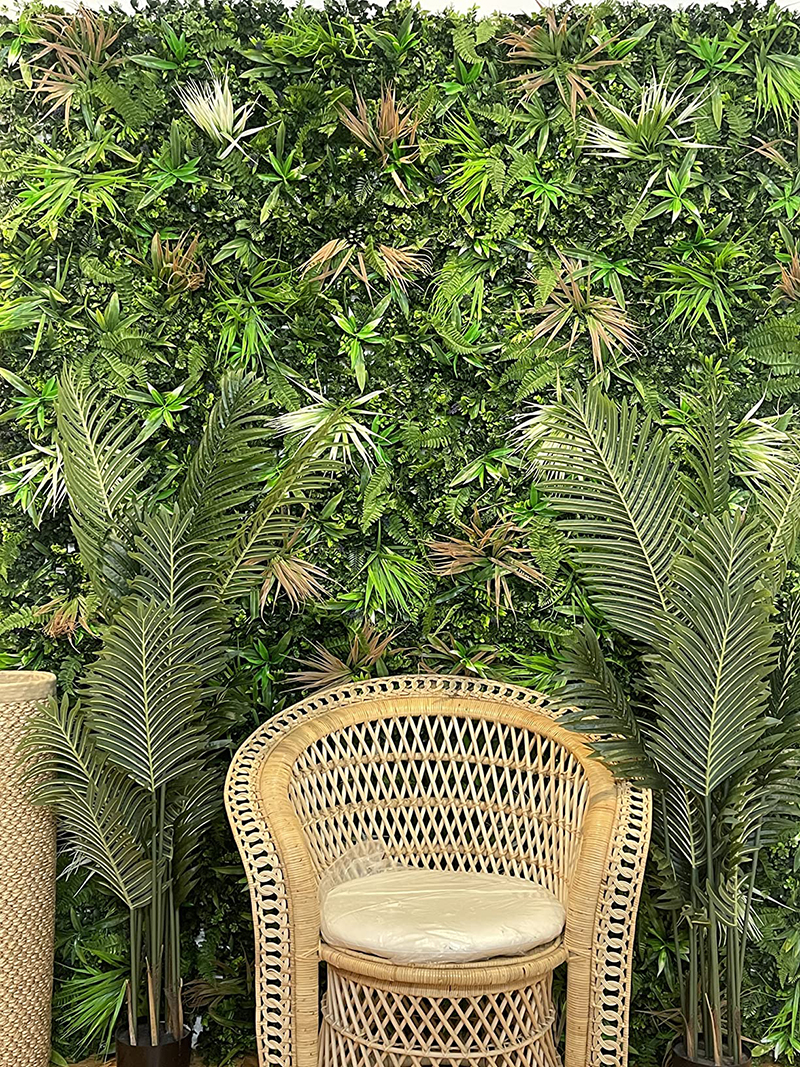The vertical garden irrigation system needs to take into account the water requirements of plants, structural space limitations, and the demands of automated management. The following is a detailed design plan for each module:
Precise water control and stratified supply
Design the irrigation intensity hierarchically based on the water requirement of plants:
Upper layer (sun-loving plants) : It requires a large amount of water and needs 2-3 short-term and high-frequency irrigations per day to prevent rapid water evaporation.
Middle layer (foliage plants) : Medium water requirement, 1-2 times a day, with irrigation duration extended by 10% to 15%.
Lower layer (shade-tolerant hanging plants) : It requires less water and is irrigated once every 2-3 days. Drip irrigation is used to keep the substrate moist.
Example: If the total height of the vertical garden is 3 meters, it can be divided into 0-1 meter (lower level), 1-2 meters (middle level), and 2-3 meters (upper level), and independent irrigation circuits can be set up for each.
Pressure balance to avoid water accumulation
Vertical irrigation needs to overcome the influence of gravity. Pressure compensation devices should be installed at the end of the system to ensure uniform irrigation in each layer.
The pressure-compensating dripper is adopted. When the water pressure fluctuates, the dripper automatically adjusts the water output to maintain a stable flow rate of 2 to 4 liters per minute.
Intelligent control, energy and water conservation
Install the humidity sensor to be linked with the timer. When the substrate moisture is lower than the set value (such as 30%-40%), the irrigation will be automatically initiated.
When the humidity is high at night, suspend irrigation. During the hot daytime, replenish water at different times to reduce evaporation waste.
Water source and filtration module
Water source: Municipal water supply, rainwater collection system or reclaimed water reuse can be selected.
Filtration: Install a mesh or disc filter to remove impurities and prevent the dripper from clogging.
If rainwater collection is adopted, a 50-100 micron filter screen should be installed in front of the water storage tank and cleaned regularly.
Pipeline and dripper layout
Main pipes: PVC or PE pipes are used and laid longitudinally along the vertical garden structure. The pipe diameter is selected based on the irrigated area (e.g., 20-32 millimeters).
Branch pipes: Laid horizontally, with the spacing adjusted according to the row spacing of plants (such as 30-50 centimeters).
Drippers: Use pressure-compensating drippers with a spacing of 15 to 30 centimeters to ensure that each plant receives a uniform amount of water.
Example: 8 to 12 drippers should be configured for each square meter of vertical garden, and the flow rate should be controlled at 2 to 4 liters per hour.
Drainage and recycling module
Drainage layer: Lay 5-10 cm thick ceramsite or gravel under the planting substrate to form drainage channels.
Recycling system: If water conservation is required, a drainage and recycling pipeline can be designed to guide the excess water back to the water storage tank, but attention should be paid to water quality filtration.
Example: The drainage slope is designed to be 1%-2% to ensure that accumulated water is drained quickly and prevent plant roots from rotting.
High-rise or independent support structure
Add a booster pump: When the height of the vertical garden exceeds 5 meters, a booster pump should be installed at the end of the system to ensure stable water pressure.
Zonal control: The vertical garden is divided into multiple irrigation areas, and each area is independently equipped with solenoid valves and sensors to achieve precise management.
Example: If the vertical garden is 8 meters high, it can be divided into three zones: upper (6-8 meters), middle (3-6 meters), and lower (0-3 meters), each controlled separately.
Complex three-dimensional structures (such as curved surfaces, multi-level)
Flexible pipes: Use flexible PE hoses to adapt to curved surfaces or irregular structures.
Combination of micro-sprinkler and drip irrigation: Use micro-sprinkler heads in densely planted areas and drippers in sparse areas to enhance irrigation efficiency.
Example: If the vertical garden includes a curved surface design, the drippers should be densely arranged at the turning points of the curved surface to ensure that there are no blind spots in irrigation.
Regular inspection
Check monthly whether there is any leakage at the pipe connections and whether the drippers are clogged.
Clean the filter and replace the damaged drippers every quarter.
If poor growth of plants is found in a certain area, it is necessary to first check whether the dripper flow rate in that area is normal.
Fault handling
Dripper blockage: Rinse with clean water or replace the dripper.
Insufficient water pressure: Check whether the booster pump or valve is open and whether the pipeline is bent.
Sensor failure: Recalibrate the humidity sensor or replace the battery.
Example: If the irrigation system suddenly stops, first check the power supply and controller, and then inspect the pipes and sensors.
Water quality regulation
If rainwater or reclaimed water is used, the pH value and salt concentration should be regularly tested to avoid damage to plants.
When the pH value is too high, ferrous sulfate can be added to adjust it to 6.0-7.0.
Nutrient supplementation
Mix water-soluble fertilizers with irrigation water to achieve integrated water and fertilizer management.
For example, add 50 to 100 grams of compound fertilizer containing nitrogen, phosphorus and potassium per cubic meter of irrigation water, and control the concentration at 0.1% to 0.2%.
Biological control
Adding microbial agents to the irrigation system can improve the substrate ecology and reduce the occurrence of diseases.
Add Bacillus subtilis once every quarter to inhibit root rot.
Through the above design, the 3D artificial vertical garden irrigation system can achieve efficient, precise and sustainable water management, ensuring the healthy growth of plants while reducing the cost of manual maintenance.

Contact: Amy
Phone: 86-15311787313
E-mail: info@foszmac.com
Whatsapp:86-15311787313
Add: Fengtai District, Dacheng Road, No.24 Building, Room 203, Beijing, China